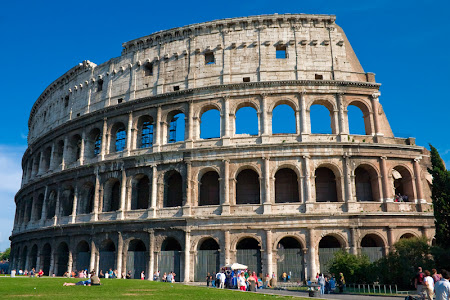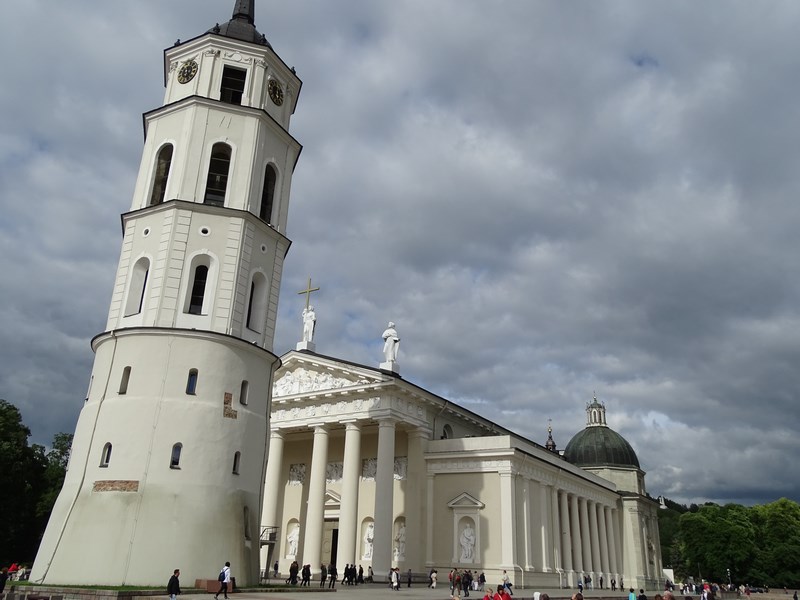Carpatair destinations: Rome – the Eternal City. Part 1
The most beautiful city in the world, the richest city in terms of art and history, the one engulfing most light and color. A city that is both popular and noble, both holy and sinful. This is Rome, the Eternal City, “Caput mundi”, where everybody can feel at home.
Caput mundi
We must have the courage and admit that in front of this city superlatives are not at all exaggerated: if there is such a thing as a place that deserves them all, this should be Rome. “The Eternal City” transcends time, transversing the eras: worlds and millennia overlap on the streets and plazas of the seven hills, in a fascinating game of suggestions, innuendos and disclosures, differences and similarities. An un-rivaled richness, joined by an equally natural joy of life. “Caput mundi” fully aware of itself, Rome embodies the very ability of greeting guests. It is impossible to feel you are foreigner here, because this is the way Romans are: “their” Coliseum, “their” Basilica San Pietro, “their” Fontana di Trevi are actually places of open identity, greeting everybody in the most natural way – sometimes with the mere smile of the ice-cream man or the smart reply of a sales girl in a gift shop.
Everything is so close to you in this city, the capital of Italy and of the whole world
Any time and any season, Rome provides its best to those willing to visit it – even in winter (since it is never too cold here) – eager to share the vastness of its millenary history, the splendor of a culture like no other, the intensity of universal spirituality joined – as Rome seems to be made with the goal of uniting everything and everybody – with the flavors of its genuine cuisine, the pleasure of going for a downtown shopping spree or enjoying the atmosphere of the coffee shops reminding one of “La Dolce Vita”. It’s really easy to explore Rome: either on foot, or by bus. You can take the No. 40 to cross downtown Rome, not to mention that a 3-minute ride by subway will take you from Piazza di Spagna to San Pietro. Everything is so close to you in this city, the capital of Italy and of the whole world. “No matter if you walk or simply stand in one place, you can see landscapes of all kinds: palaces and ruins, gardens and open horizons, triumph arches and columns – more often than not, they are all mingled together and they could all fit on a piece of paper”, as written by the great Wolfgang Goethe wrote back in 1816, during his stay in Rome. This is the city where visitors can follow their own trajectory, entering the many universes that shape and define the essence of Rome: Ancient Rome, Renaissance and Baroque Rome, Christian Rome – the three perspectives allowing us to approach this immense wealth. They are all “perspectives”, not a mere “list” of treasures: “One would need a thousand quills to describe them”, admits the same Goethe. And we are talking about Goethe here…
Eternal Majesty: Ancient Rome
Our stroll in Rome begins with Piazza del Campidoglio (Capitolium Plaza), the administrative area of the city since its very beginnings: a place where the Renaissance geometry of Michelangelo, the equestrian statue of Emperor Marc Aurelius and the Santa Maria in Aracoeli Church, going back to the 14th century, capture the structural coexistence of three different eras: the ancient, the medieval and the Renaissance times, a majestic presence introducing another one, even more majestic, standing a few meters away: The Roman Forum and the Imperial Forums. All the major achievements of Imperial Rome were first decided and celebrated here. This is the heart of Ancient Rome’s glory, also hosting the daily life of a city that has dominated the world, among temples and churches, plazas and powerful palaces. Two thousand years later, our hands can touch these prints starting – together with the Avenue of Imperial Forums, built by Mussolini in celebration of his regime – with the Column of Trajan. This is a memento of Trajan’s conquest of Dacia, but also of the riches the Empire had gained from the territory of the Romania today. We should not be misled by the fact that the Roman Forum also has its ruins here nowadays, as life has been pulsating around for centuries in a row. This used to be a place where people were buying and selling goods, meeting and discussing. They made their laws and celebrated their rituals here. And with the neighboring Imperial Forums of Caesar, Augustus and Trajan, the power of Rome built new monuments dedicated to its own glory. The green of pines dominates the archeological area (if not the entire city), bringing a hint of vital freshness to the imposing solemn structure of the Coliseum, the most famous “postcard” from Rome sent all over the world.
In spite of the heavy toll of time, this huge structure still evokes in an impressive way the image of the ancient public games of the Imperial Era – especially those between gladiators or gladiators and wild animals. The incredible technology of building a whole stadium two thousand years ago (which remains a model for many modern stadiums as well), hosting up to 70,000 people, has never ceased to amaze. Cars are speeding away on the Avenue of the Forums; authorities have often tried to close traffic down, in order for this archeological area to regain its ancient fascination, but nobody has succeeded so far.
However, one can safely stroll on the sidewalk going to Venice Plaza, reaching the geometrical center of Rome in a matter of minutes. This is the place where the 20th century Shrine of the Country presents Italy’s homage to The Anonymous Soldier. This is a tourist landmark worth keeping in mind, since it can be the start of two major routes: one leading to the triangle that goes all the way up to Via Nazionale, then down to Piazza del Popolo and back on Via del Corso; and the other one with Corso Vittorio Emanuele leading to Castel Sant’Angelo with a few loops in the areas flanking Corso on the left and on the right.
Enjoying Art amidst Coffee Shops and Shopping Sprees: Baroque Rome
Rome is a city one has to enjoy at its fullest. From this point of view, it is perhaps the most attractive city in Italy, which certainly makes you enjoy life with the luminosity of its skies, the colors of its buildings, and the warmth of its people. Among churches and noble palaces, there is a whole explosion of vintage window shops and coffee shops, providing visitors with great opportunities for every taste and for every budget. Of course, the top of the world elegance includes Piazza di Spagna – Via Condotti, Via Frattina, Via della Croce, the favorites of those looking for famous designer shops such as Valentino, Giorgio Armani, Trussardi, Yves Saint Laurent, Gucci – even if the same area hosts brands that are less famous abroad, but highly representative of Roman elegance and refinement, such as: feminine fashion by Carla G, accessories by Braccialini, scarves and ties by Giorgio Sermoneta. Anyway, between Via del Tritone, Via Barberini and Via Nazionale one can find great opportunities for any budget, especially in terms of clothing and footwear.
The ambiance is relaxed down here, in the constant hustle and bustle of shopping, with an atmosphere that invites one to sit for a while in one of the vintage downtown coffee shops.
Two of the most prestigious, which you should not miss, are Caffè Greco, on Via dei Condotti, with chambers decorated in wood and mirrors that used to greet Wagner, Goethe, Stendhal and Bizet a while ago; and Caffè Atelier Canova, located in the former shop of sculptor Antonio Canova (on Via del Babuino), Enjoying Art amidst Coffee Shops and Shopping Sprees: Baroque Rome Elegance and color meet in Piazza di Spagna, an international saloon in open air where you can have an appetizer or a cup of coffee among old plaster statues and sketches. Close to this spot, in Piazza del Popolo, another Canova Bar used to have Federico Fellini as its loyal customer – (the director of “dolce vita”), the unforgettable era of post-war Rome, with the neighboring Via Veneto as its distinctive symbol.
Elegance and color meet in Piazza di Spagna, an international saloon in the open air with a set including Bernini’s well (Pietro and Gian Lorenzo), Scalinata Trinità dei Monti and the splendid panorama of Pincio. This encapsulates Rome’s joy of living, both by day and by night, between lights and water – such as Fontana di Trevi, one of the symbols of Baroque Rome, where, according to the legend, you must throw a coin in order to make sure you will revisit the Eternal City. This is a truly exceptional place, and it is no coincidence that very close to it, you can find the main palaces of power: Quirinale, the seat of the Italian Republic President, Palazzo Chigi and Montecitorio, the headquarters of the Council Presidency and the Deputy Chamber. For a while, Quirinale used to be the residence of the Pope, this is why next to this palace you can also see the two main protagonists of Baroque Rome: Gian Lorenzo Bernini and Francesco Borromini, lifelong rivals driven by this mutual feeling to place their works next to one another – for example, Chiesa di Sant’Andrea at the Quirinale (the absolute masterpiece of Bernini) and Chiesa di San Carlino at Quattro Fontane (the masterpiece of Borromini).
The fact that Popes between the 16th and the 17th century had summoned to Rome the leading artists of that time – Michelangelo and Raffaello, to name just the two giants – laid the foundation of the Renaissance and Baroque face of the city. Also here you can find an exceptional Roman style and Oriental influences, such as in the churches Santa Maria in Trastevere, Santa Maria in Cosmedin, San Giorgio al Velabro and others. You can also see it starting with Chiesa del Gesù (a model for all the Roman baroque churches), Sant’Andrea della Valle (with a dome ranking second in the top of the biggest ones, after the one at San Pietro), Sant’Ignazio (with the most imposing example of perspective painting in the world: if you study the painted figures on the ceiling and move along the central body of the building, you can see their profile remains unchanged, as if they were also strolling along with you). The same prolific creation era generated the charm of spectacular plazas such as Piazza di Spagna and Piazza Navona, with Bernini’s well in the middle. According to a famous legend, the frightened look of the statues opposing the well is focused – in a straight-forward gesture of disgust – on the Chiesa di Santa Agnese, by rival Borromini, standing right in front of it and displaying a corresponding expression, in response to this. The beauty of Rome also lies in the fact that you do not have to be an expert or a passionate art lover in order to enjoy all these marvels, as Rome is too full of life for art to become a burden.
The playful and sociable characteristics seem to make the law of this city, where every church and every palace is always surrounded by a popular context: no matter if we are talking about the market in Campo de’ Fiori (you must definitely go there, this is Rome living and breathing its everyday life) or about the typical little streets full of pubs in Trastevere, Rome never has any room left for snobbery or vulgarity. Rome is the Eternal City, both elegant and popular.
Pictures of Rome:
Colliseum – by day
Colliseum – by night
Campidoglio
Piazza di Venezia

















